warning FORD E SERIES 2004 4.G Owner's Manual
[x] Cancel search | Manufacturer: FORD, Model Year: 2004, Model line: E SERIES, Model: FORD E SERIES 2004 4.GPages: 240, PDF Size: 3.62 MB
Page 144 of 240
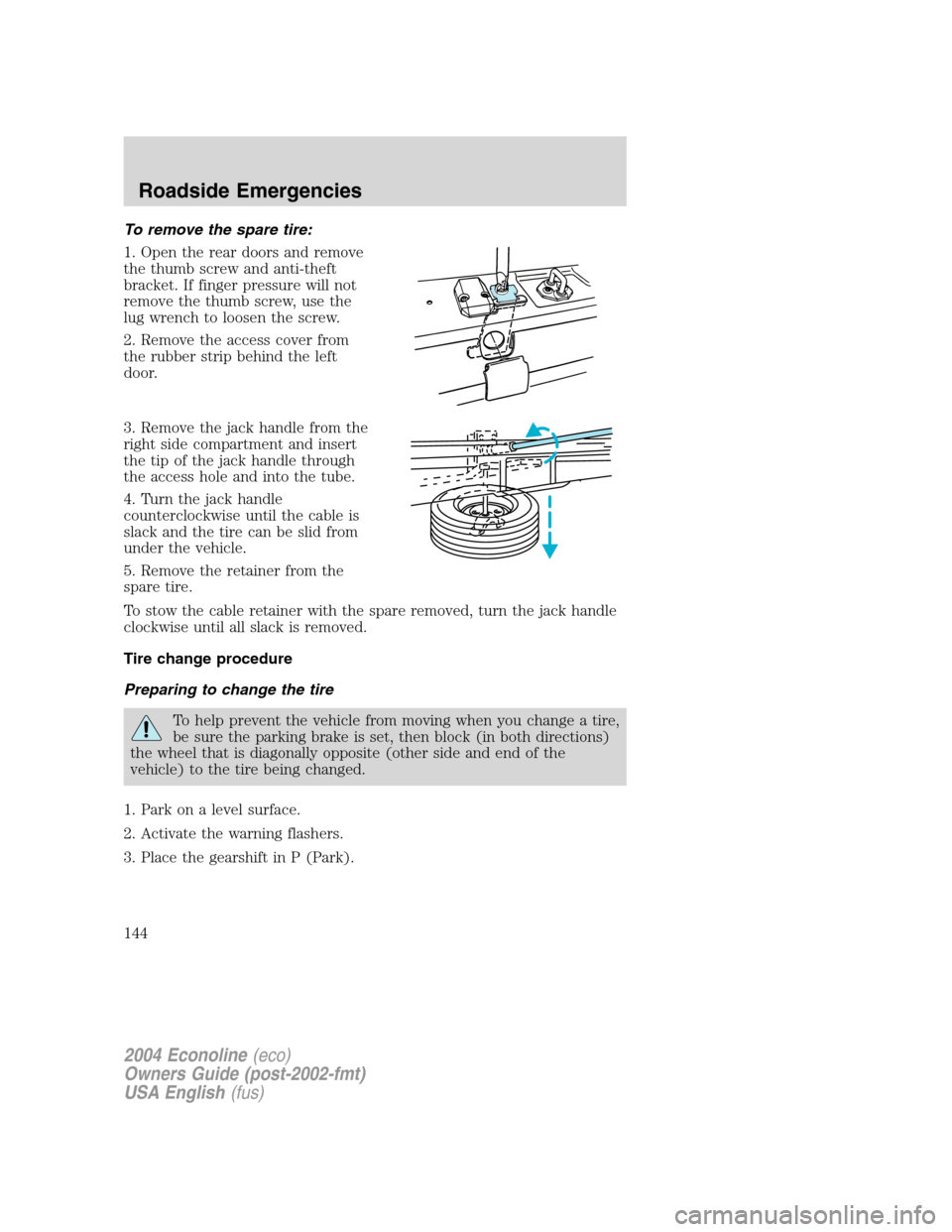
To remove the spare tire:
1. Open the rear doors and remove
the thumb screw and anti-theft
bracket. If finger pressure will not
remove the thumb screw, use the
lug wrench to loosen the screw.
2. Remove the access cover from
the rubber strip behind the left
door.
3. Remove the jack handle from the
right side compartment and insert
the tip of the jack handle through
the access hole and into the tube.
4. Turn the jack handle
counterclockwise until the cable is
slack and the tire can be slid from
under the vehicle.
5. Remove the retainer from the
spare tire.
To stow the cable retainer with the spare removed, turn the jack handle
clockwise until all slack is removed.
Tire change procedure
Preparing to change the tire
To help prevent the vehicle from moving when you change a tire,
be sure the parking brake is set, then block (in both directions)
the wheel that is diagonally opposite (other side and end of the
vehicle) to the tire being changed.
1. Park on a level surface.
2. Activate the warning flashers.
3. Place the gearshift in P (Park).
2004 Econoline(eco)
Owners Guide (post-2002-fmt)
USA English(fus)
Roadside Emergencies
144
Page 197 of 240
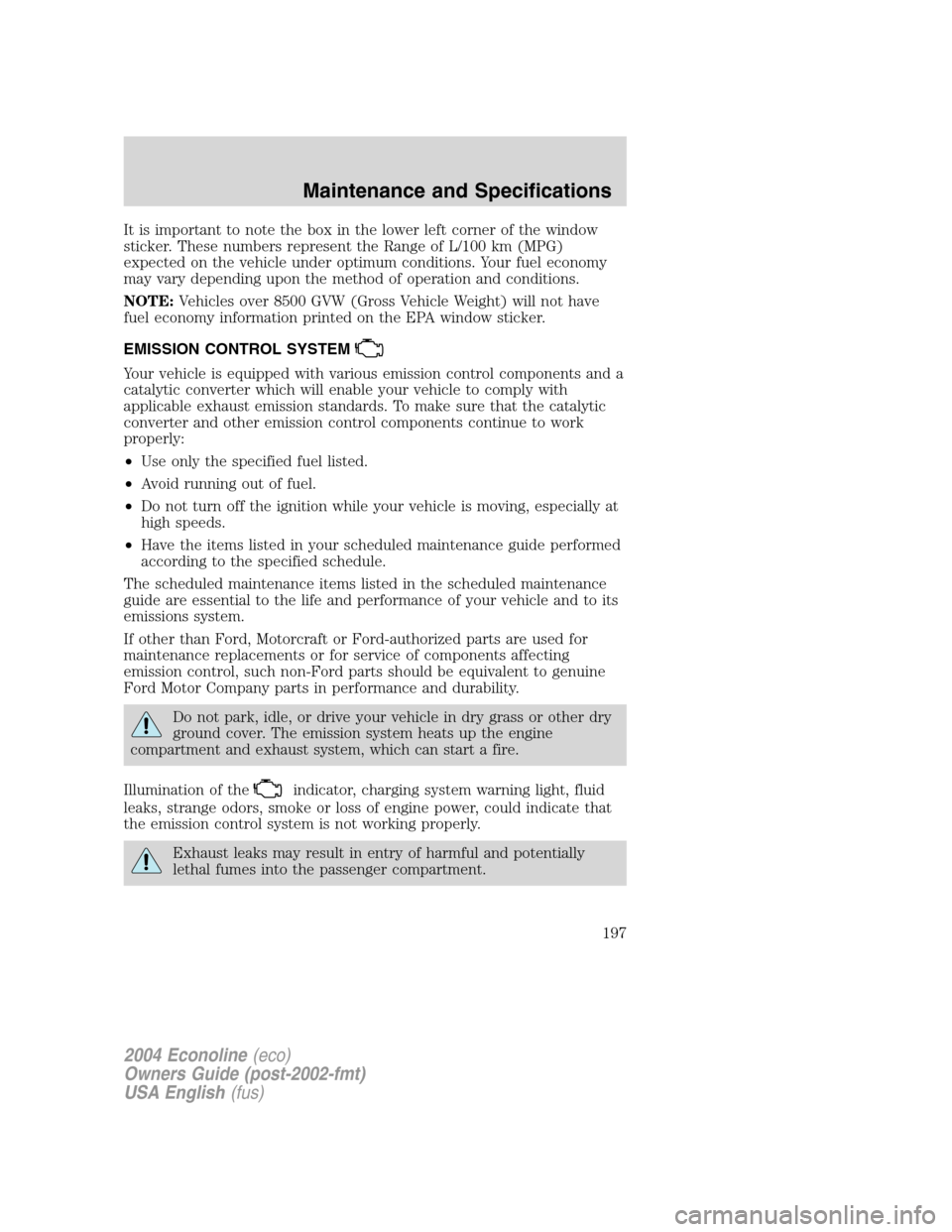
It is important to note the box in the lower left corner of the window
sticker. These numbers represent the Range of L/100 km (MPG)
expected on the vehicle under optimum conditions. Your fuel economy
may vary depending upon the method of operation and conditions.
NOTE:Vehicles over 8500 GVW (Gross Vehicle Weight) will not have
fuel economy information printed on the EPA window sticker.
EMISSION CONTROL SYSTEM
Your vehicle is equipped with various emission control components and a
catalytic converter which will enable your vehicle to comply with
applicable exhaust emission standards. To make sure that the catalytic
converter and other emission control components continue to work
properly:
•Use only the specified fuel listed.
•Avoid running out of fuel.
•Do not turn off the ignition while your vehicle is moving, especially at
high speeds.
•Have the items listed in your scheduled maintenance guide performed
according to the specified schedule.
The scheduled maintenance items listed in the scheduled maintenance
guide are essential to the life and performance of your vehicle and to its
emissions system.
If other than Ford, Motorcraft or Ford-authorized parts are used for
maintenance replacements or for service of components affecting
emission control, such non-Ford parts should be equivalent to genuine
Ford Motor Company parts in performance and durability.
Do not park, idle, or drive your vehicle in dry grass or other dry
ground cover. The emission system heats up the engine
compartment and exhaust system, which can start a fire.
Illumination of the
indicator, charging system warning light, fluid
leaks, strange odors, smoke or loss of engine power, could indicate that
the emission control system is not working properly.
Exhaust leaks may result in entry of harmful and potentially
lethal fumes into the passenger compartment.
2004 Econoline(eco)
Owners Guide (post-2002-fmt)
USA English(fus)
Maintenance and Specifications
197
Page 198 of 240
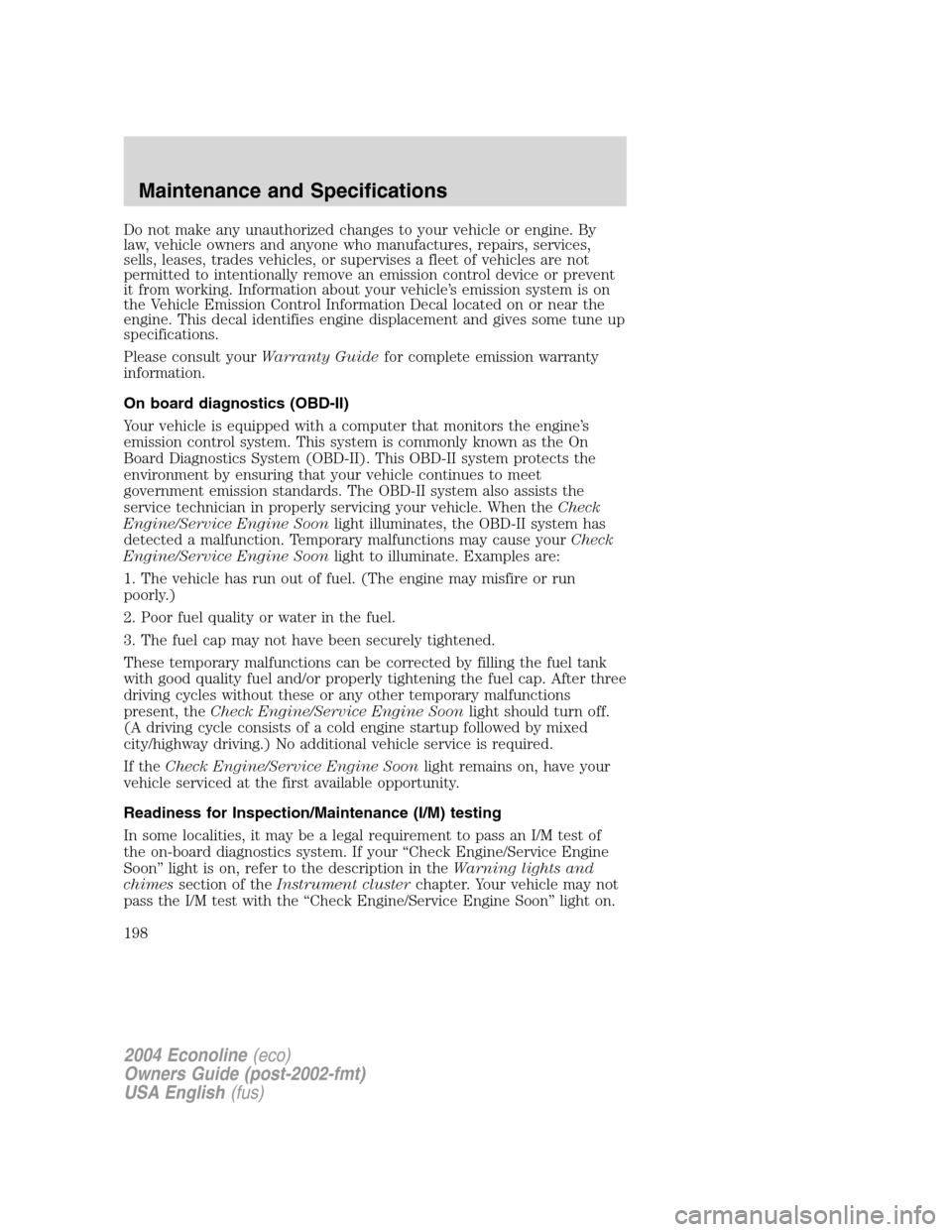
Do not make any unauthorized changes to your vehicle or engine. By
law, vehicle owners and anyone who manufactures, repairs, services,
sells, leases, trades vehicles, or supervises a fleet of vehicles are not
permitted to intentionally remove an emission control device or prevent
it from working. Information about your vehicle’s emission system is on
the Vehicle Emission Control Information Decal located on or near the
engine. This decal identifies engine displacement and gives some tune up
specifications.
Please consult yourWarranty Guidefor complete emission warranty
information.
On board diagnostics (OBD-II)
Your vehicle is equipped with a computer that monitors the engine’s
emission control system. This system is commonly known as the On
Board Diagnostics System (OBD-II). This OBD-II system protects the
environment by ensuring that your vehicle continues to meet
government emission standards. The OBD-II system also assists the
service technician in properly servicing your vehicle. When theCheck
Engine/Service Engine Soonlight illuminates, the OBD-II system has
detected a malfunction. Temporary malfunctions may cause yourCheck
Engine/Service Engine Soonlight to illuminate. Examples are:
1. The vehicle has run out of fuel. (The engine may misfire or run
poorly.)
2. Poor fuel quality or water in the fuel.
3. The fuel cap may not have been securely tightened.
These temporary malfunctions can be corrected by filling the fuel tank
with good quality fuel and/or properly tightening the fuel cap. After three
driving cycles without these or any other temporary malfunctions
present, theCheck Engine/Service Engine Soonlight should turn off.
(A driving cycle consists of a cold engine startup followed by mixed
city/highway driving.) No additional vehicle service is required.
If theCheck Engine/Service Engine Soonlight remains on, have your
vehicle serviced at the first available opportunity.
Readiness for Inspection/Maintenance (I/M) testing
In some localities, it may be a legal requirement to pass an I/M test of
the on-board diagnostics system. If your“Check Engine/Service Engine
Soon”light is on, refer to the description in theWarning lights and
chimessection of theInstrument clusterchapter. Your vehicle may not
pass the I/M test with the“Check Engine/Service Engine Soon”light on.
2004 Econoline(eco)
Owners Guide (post-2002-fmt)
USA English(fus)
Maintenance and Specifications
198
Page 200 of 240
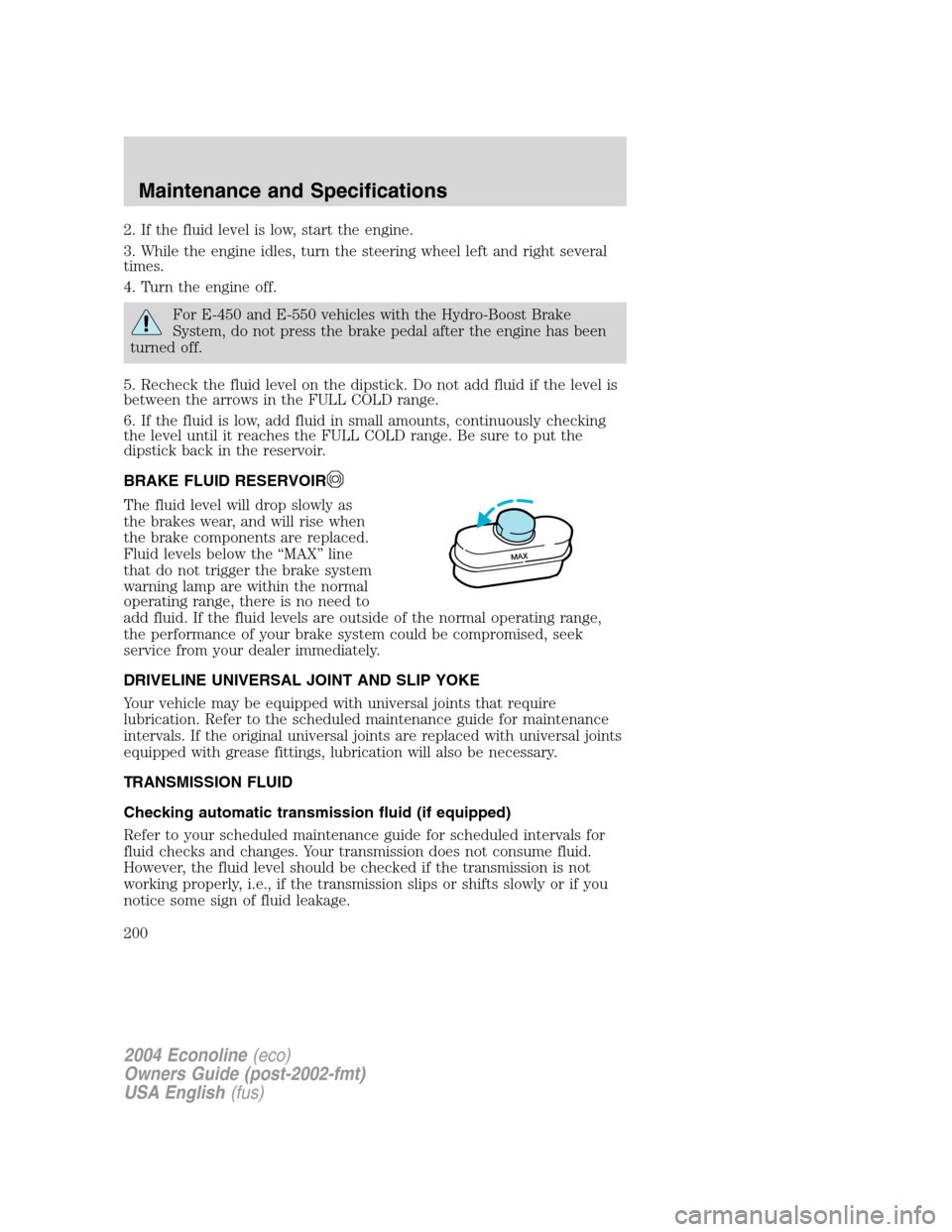
2. If the fluid level is low, start the engine.
3. While the engine idles, turn the steering wheel left and right several
times.
4. Turn the engine off.
For E-450 and E-550 vehicles with the Hydro-Boost Brake
System, do not press the brake pedal after the engine has been
turned off.
5. Recheck the fluid level on the dipstick. Do not add fluid if the level is
between the arrows in the FULL COLD range.
6. If the fluid is low, add fluid in small amounts, continuously checking
the level until it reaches the FULL COLD range. Be sure to put the
dipstick back in the reservoir.
BRAKE FLUID RESERVOIR
The fluid level will drop slowly as
the brakes wear, and will rise when
the brake components are replaced.
Fluid levels below the“MAX”line
that do not trigger the brake system
warning lamp are within the normal
operating range, there is no need to
add fluid. If the fluid levels are outside of the normal operating range,
the performance of your brake system could be compromised, seek
service from your dealer immediately.
DRIVELINE UNIVERSAL JOINT AND SLIP YOKE
Your vehicle may be equipped with universal joints that require
lubrication. Refer to the scheduled maintenance guide for maintenance
intervals. If the original universal joints are replaced with universal joints
equipped with grease fittings, lubrication will also be necessary.
TRANSMISSION FLUID
Checking automatic transmission fluid (if equipped)
Refer to your scheduled maintenance guide for scheduled intervals for
fluid checks and changes. Your transmission does not consume fluid.
However, the fluid level should be checked if the transmission is not
working properly, i.e., if the transmission slips or shifts slowly or if you
notice some sign of fluid leakage.
M
AX
2004 Econoline(eco)
Owners Guide (post-2002-fmt)
USA English(fus)
Maintenance and Specifications
200
Page 208 of 240
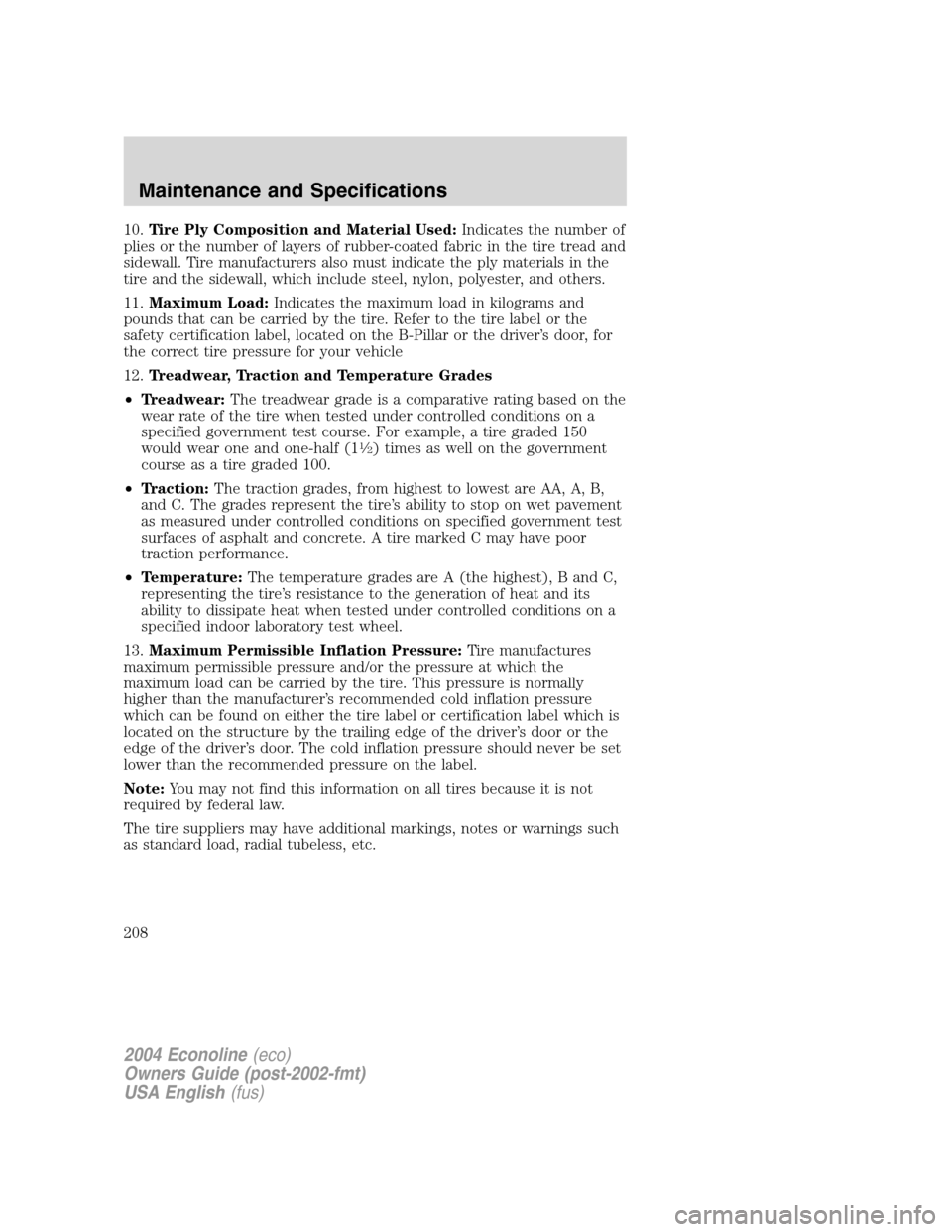
10.Tire Ply Composition and Material Used:Indicates the number of
plies or the number of layers of rubber-coated fabric in the tire tread and
sidewall. Tire manufacturers also must indicate the ply materials in the
tire and the sidewall, which include steel, nylon, polyester, and others.
11.Maximum Load:Indicates the maximum load in kilograms and
pounds that can be carried by the tire. Refer to the tire label or the
safety certification label, located on the B-Pillar or the driver’s door, for
the correct tire pressure for your vehicle
12.Treadwear, Traction and Temperature Grades
•Treadwear:The treadwear grade is a comparative rating based on the
wear rate of the tire when tested under controlled conditions on a
specified government test course. For example, a tire graded 150
would wear one and one-half (1
1�2) times as well on the government
course as a tire graded 100.
•Traction:The traction grades, from highest to lowest are AA, A, B,
and C. The grades represent the tire’s ability to stop on wet pavement
as measured under controlled conditions on specified government test
surfaces of asphalt and concrete. A tire marked C may have poor
traction performance.
•Temperature:The temperature grades are A (the highest), B and C,
representing the tire’s resistance to the generation of heat and its
ability to dissipate heat when tested under controlled conditions on a
specified indoor laboratory test wheel.
13.Maximum Permissible Inflation Pressure:Tire manufactures
maximum permissible pressure and/or the pressure at which the
maximum load can be carried by the tire. This pressure is normally
higher than the manufacturer’s recommended cold inflation pressure
which can be found on either the tire label or certification label which is
located on the structure by the trailing edge of the driver’s door or the
edge of the driver’s door. The cold inflation pressure should never be set
lower than the recommended pressure on the label.
Note:You may not find this information on all tires because it is not
required by federal law.
The tire suppliers may have additional markings, notes or warnings such
as standard load, radial tubeless, etc.
2004 Econoline(eco)
Owners Guide (post-2002-fmt)
USA English(fus)
Maintenance and Specifications
208
Page 212 of 240
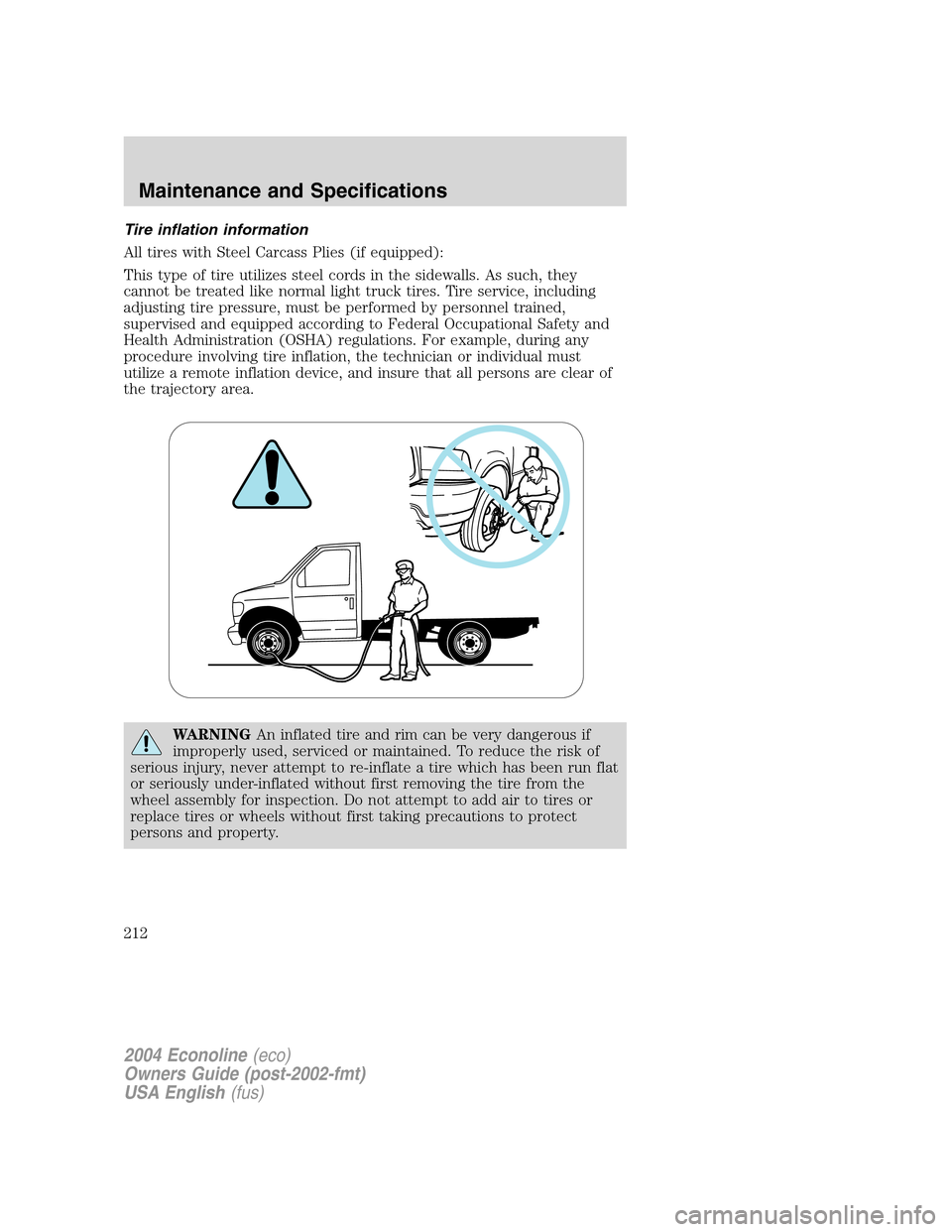
Tire inflation information
All tires with Steel Carcass Plies (if equipped):
This type of tire utilizes steel cords in the sidewalls. As such, they
cannot be treated like normal light truck tires. Tire service, including
adjusting tire pressure, must be performed by personnel trained,
supervised and equipped according to Federal Occupational Safety and
Health Administration (OSHA) regulations. For example, during any
procedure involving tire inflation, the technician or individual must
utilize a remote inflation device, and insure that all persons are clear of
the trajectory area.
WARNINGAn inflated tire and rim can be very dangerous if
improperly used, serviced or maintained. To reduce the risk of
serious injury, never attempt to re-inflate a tire which has been run flat
or seriously under-inflated without first removing the tire from the
wheel assembly for inspection. Do not attempt to add air to tires or
replace tires or wheels without first taking precautions to protect
persons and property.
2004 Econoline(eco)
Owners Guide (post-2002-fmt)
USA English(fus)
Maintenance and Specifications
212
Page 234 of 240
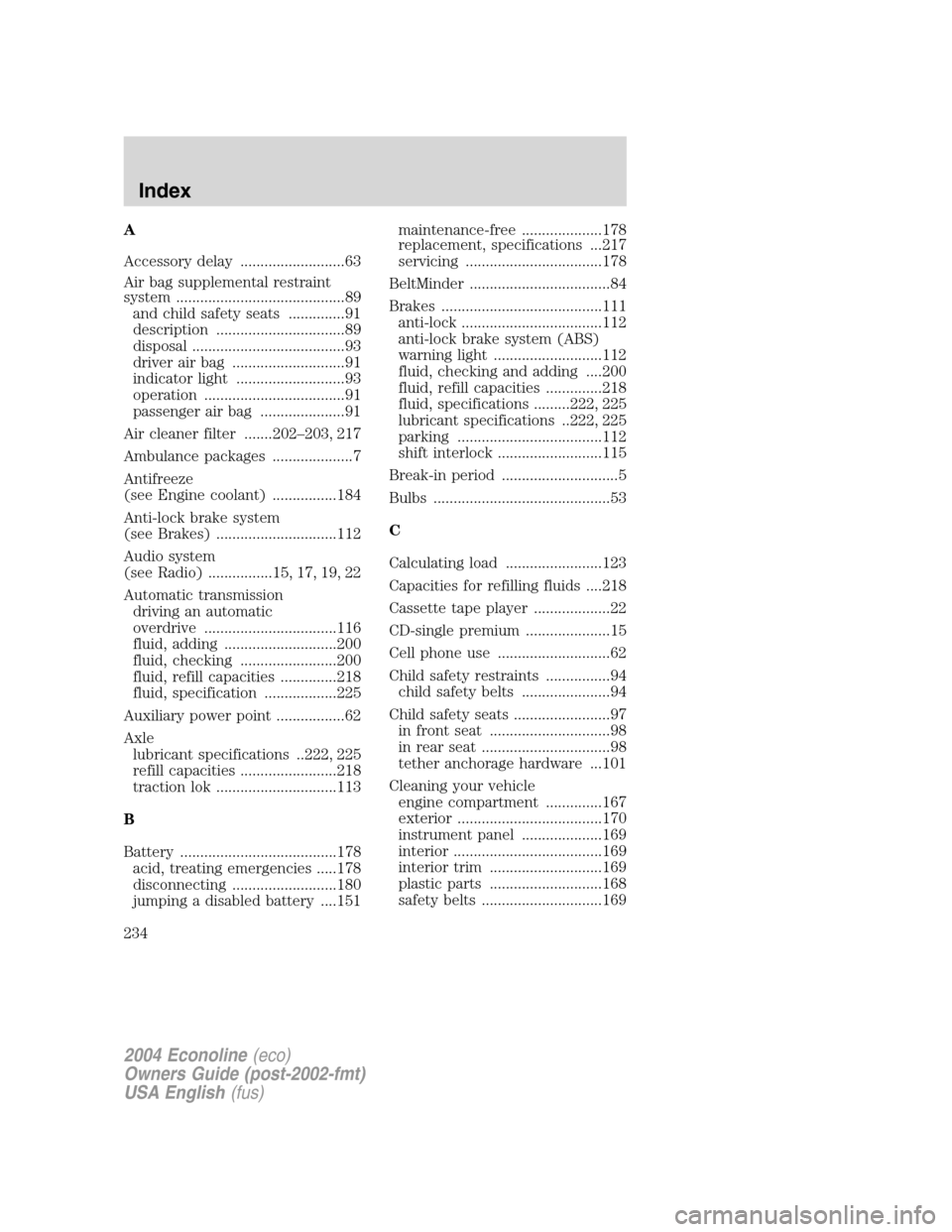
A
Accessory delay ..........................63
Air bag supplemental restraint
system ..........................................89
and child safety seats ..............91
description ................................89
disposal ......................................93
driver air bag ............................91
indicator light ...........................93
operation ...................................91
passenger air bag .....................91
Air cleaner filter .......202–203, 217
Ambulance packages ....................7
Antifreeze
(see Engine coolant) ................184
Anti-lock brake system
(see Brakes) ..............................112
Audio system
(see Radio) ................15, 17, 19, 22
Automatic transmission
driving an automatic
overdrive .................................116
fluid, adding ............................200
fluid, checking ........................200
fluid, refill capacities ..............218
fluid, specification ..................225
Auxiliary power point .................62
Axle
lubricant specifications ..222, 225
refill capacities ........................218
traction lok ..............................113
B
Battery .......................................178
acid, treating emergencies .....178
disconnecting ..........................180
jumping a disabled battery ....151maintenance-free ....................178
replacement, specifications ...217
servicing ..................................178
BeltMinder ...................................84
Brakes ........................................111
anti-lock ...................................112
anti-lock brake system (ABS)
warning light ...........................112
fluid, checking and adding ....200
fluid, refill capacities ..............218
fluid, specifications .........222, 225
lubricant specifications ..222, 225
parking ....................................112
shift interlock ..........................115
Break-in period .............................5
Bulbs ............................................53
C
Calculating load ........................123
Capacities for refilling fluids ....218
Cassette tape player ...................22
CD-single premium .....................15
Cell phone use ............................62
Child safety restraints ................94
child safety belts ......................94
Child safety seats ........................97
in front seat ..............................98
in rear seat ................................98
tether anchorage hardware ...101
Cleaning your vehicle
engine compartment ..............167
exterior ....................................170
instrument panel ....................169
interior .....................................169
interior trim ............................169
plastic parts ............................168
safety belts ..............................169
2004 Econoline(eco)
Owners Guide (post-2002-fmt)
USA English(fus)
Index
Index
234
Page 237 of 240
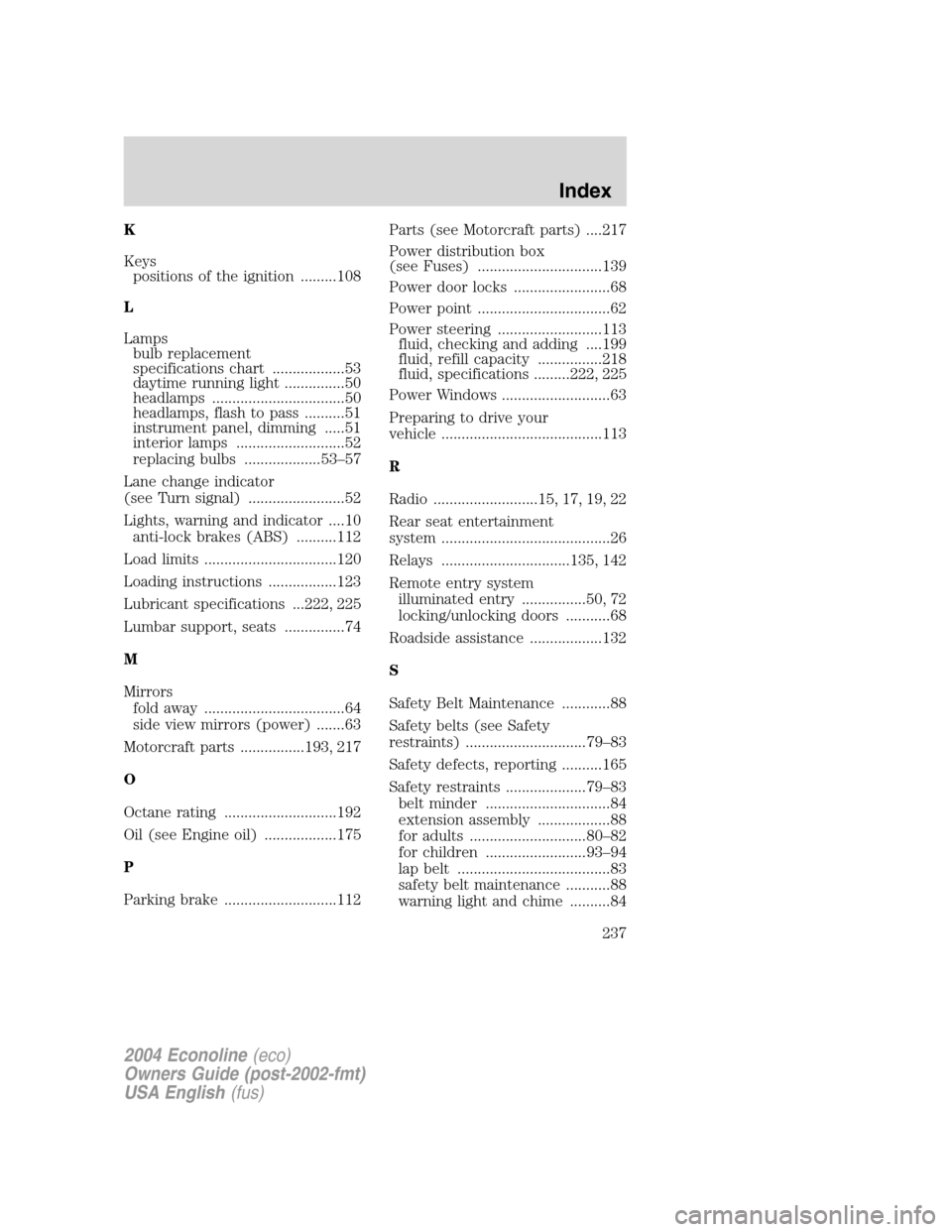
K
Keys
positions of the ignition .........108
L
Lamps
bulb replacement
specifications chart ..................53
daytime running light ...............50
headlamps .................................50
headlamps, flash to pass ..........51
instrument panel, dimming .....51
interior lamps ...........................52
replacing bulbs ...................53–57
Lane change indicator
(see Turn signal) ........................52
Lights, warning and indicator ....10
anti-lock brakes (ABS) ..........112
Load limits .................................120
Loading instructions .................123
Lubricant specifications ...222, 225
Lumbar support, seats ...............74
M
Mirrors
fold away ...................................64
side view mirrors (power) .......63
Motorcraft parts ................193, 217
O
Octane rating ............................192
Oil (see Engine oil) ..................175
P
Parking brake ............................112Parts (see Motorcraft parts) ....217
Power distribution box
(see Fuses) ...............................139
Power door locks ........................68
Power point .................................62
Power steering ..........................113
fluid, checking and adding ....199
fluid, refill capacity ................218
fluid, specifications .........222, 225
Power Windows ...........................63
Preparing to drive your
vehicle ........................................113
R
Radio ..........................15, 17, 19, 22
Rear seat entertainment
system ..........................................26
Relays ................................135, 142
Remote entry system
illuminated entry ................50, 72
locking/unlocking doors ...........68
Roadside assistance ..................132
S
Safety Belt Maintenance ............88
Safety belts (see Safety
restraints) ..............................79–83
Safety defects, reporting ..........165
Safety restraints ....................79–83
belt minder ...............................84
extension assembly ..................88
for adults .............................80–82
for children .........................93–94
lap belt ......................................83
safety belt maintenance ...........88
warning light and chime ..........84
2004 Econoline(eco)
Owners Guide (post-2002-fmt)
USA English(fus)
Index
237
Page 238 of 240
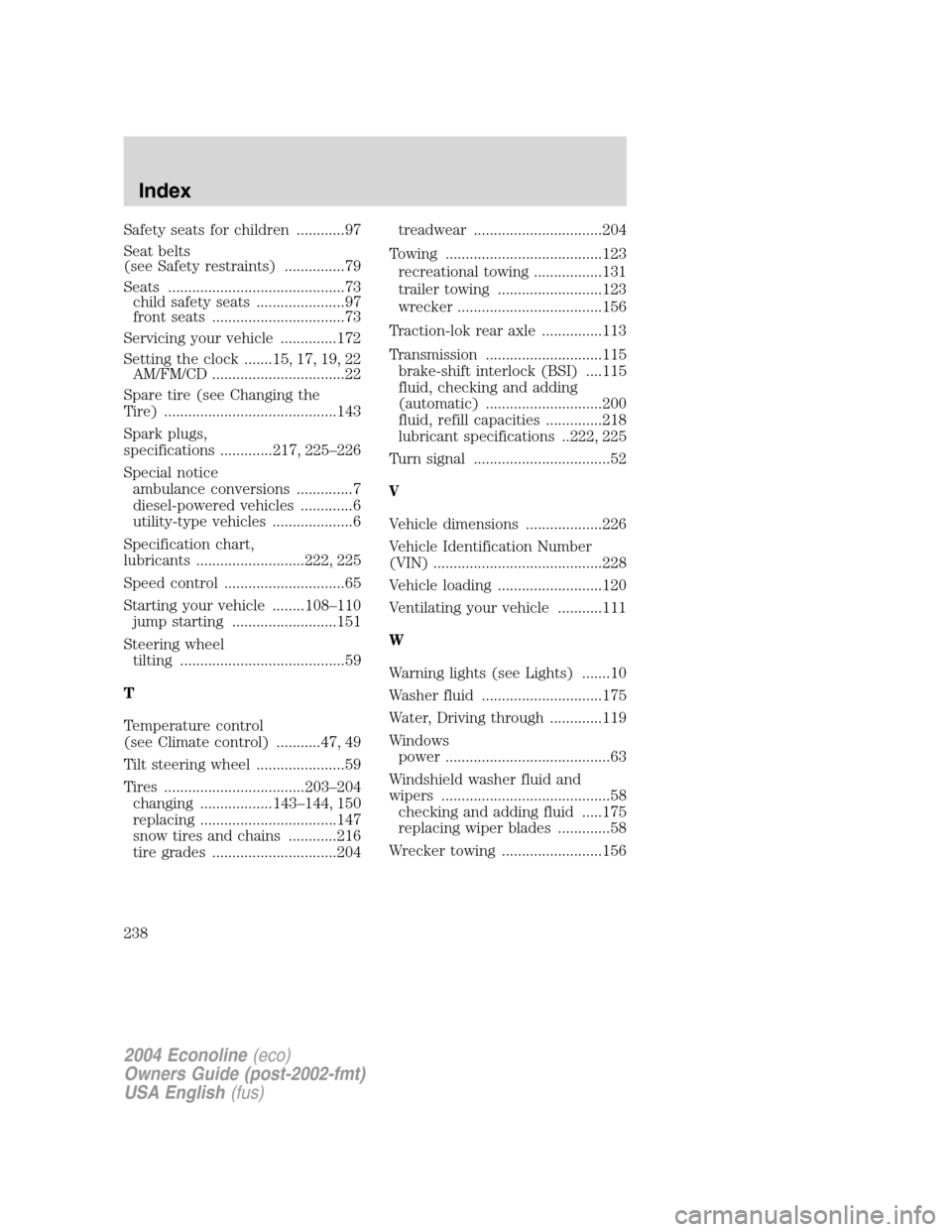
Safety seats for children ............97
Seat belts
(see Safety restraints) ...............79
Seats ............................................73
child safety seats ......................97
front seats .................................73
Servicing your vehicle ..............172
Setting the clock .......15, 17, 19, 22
AM/FM/CD .................................22
Spare tire (see Changing the
Tire) ...........................................143
Spark plugs,
specifications .............217, 225–226
Special notice
ambulance conversions ..............7
diesel-powered vehicles .............6
utility-type vehicles ....................6
Specification chart,
lubricants ...........................222, 225
Speed control ..............................65
Starting your vehicle ........108–110
jump starting ..........................151
Steering wheel
tilting .........................................59
T
Temperature control
(see Climate control) ...........47, 49
Tilt steering wheel ......................59
Tires ...................................203–204
changing ..................143–144, 150
replacing ..................................147
snow tires and chains ............216
tire grades ...............................204treadwear ................................204
Towing .......................................123
recreational towing .................131
trailer towing ..........................123
wrecker ....................................156
Traction-lok rear axle ...............113
Transmission .............................115
brake-shift interlock (BSI) ....115
fluid, checking and adding
(automatic) .............................200
fluid, refill capacities ..............218
lubricant specifications ..222, 225
Turn signal ..................................52
V
Vehicle dimensions ...................226
Vehicle Identification Number
(VIN) ..........................................228
Vehicle loading ..........................120
Ventilating your vehicle ...........111
W
Warning lights (see Lights) .......10
Washer fluid ..............................175
Water, Driving through .............119
Windows
power .........................................63
Windshield washer fluid and
wipers ..........................................58
checking and adding fluid .....175
replacing wiper blades .............58
Wrecker towing .........................156
2004 Econoline(eco)
Owners Guide (post-2002-fmt)
USA English(fus)
Index
238